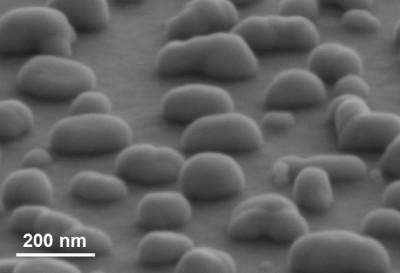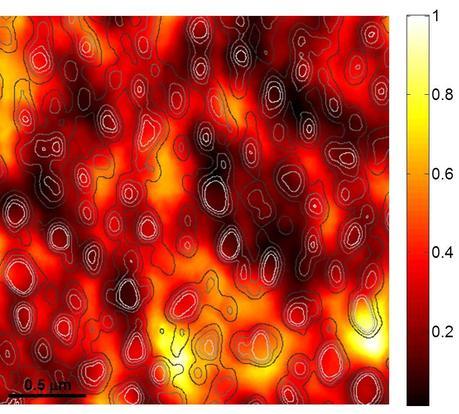 The silver nanoparticles are irregularly shaped and randomly distributed over the
The silver nanoparticles are irregularly shaped and randomly distributed over the surface, as shown by the scanning electron microscope image. (Credit: HZB)
Nanostructures could enable more light to be directed into the active layer of solar cells, increasing their efficiency.
Prof. Martina Schmid (HZB) has now measured how irregularly distributed silver nanoparticles influence the absorption of light. She demonstrated that silver nanoparticles interact with one another via their electromagnetic near-fields, so that local “hot spots” arise where light is concentrated especially strongly.
It is desirable even with thin-film solar cells to utilize less material and thereby save on fabrication costs. As an example, chalcopyrite cells (i.e. copper-indium-gallium-diselenide, or ‘CIGS’ cells) in part consist of rare-earth elements like indium and gallium. If the active layer is made too thin, however, it absorbs too little light and the efficiency level drops. Nanostructures on top of the active material might be able to capture the light and thus increase the efficiency. This idea is being pursued by Prof. Martina Schmid, who heads the NanooptiX group of junior scientists at HZB and holds a junior professorship at Freie University Berlin. “Our objective is to optimize nanostructures so they selectively direct certain wavelengths of the solar spectrum into the cells.”
In collaboration with colleagues at the California Institute of Technology, Schmid investigated how these types of randomly distributed nanoparticles influence the incidence of light on a cell below. They used a particularly sensitive method known as scanning near-field optical microscopy (SNOM). In this technique, an extremely tiny point scans the sample, determining the topography as with atomic force microscopy. However, it also simultaneously illuminates the sample through an even smaller aperture in the probe point to create optical excitations (plasmons) in the nanoparticles. These optical excitations can either couple the light into the solar cell as desired—or instead transform the light into heat, whereby it is lost to the solar cell.

The topography of the sample surface can be seen here (white lines around the nano-particles) as well as the local optical excitations. The image displays several “hot spots” (yellow) that arise through interactions of the nanoparticles with the light and also with one another. (Credit: HZB / CalTech)
Measurements showed that there can be strong interactions between densely situated, irregularly distributed nanoparticles leading to local “hot spots.”
“Whereas the darker regions tend to absorb light and transform it into heat, the hot spots show where nanoparticles strongly interact via their electromagnetic near-fields. In these regions of enhanced fields, energy transformation in the solar cell could potentially be enhanced,” Martina Schmid explains.
In the end, areas of stronger fields but also of comparatively weaker ones arise. However, it is difficult to establish a clear relationship between the occurrence of these hot spots and specific nanoparticles. “The particles mutually affect one another through their electromagnetic near-fields, which are notably more complex than suspected until now. We need to ascertain how we can intentionally create the desired field distributions,” explains Schmid. She will investigate these questions further at HZB and at the Freie Universität Berlin together with the research group headed by Prof. Paul Fumagalli.
Schmid, M., Grandidier, J., & Atwater, H. (2013). Scanning near-field optical microscopy on dense random assemblies of metal nanoparticles Journal of Optics, 15 (12) DOI: 10.1088/2040-8978/15/12/125001
